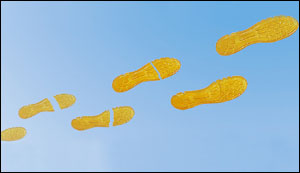Broke your shoe? What if it could repair itself?
6. 2. 2019 | USC Vitebri School of Engineering | viterbischool.usc.edu
Instead of throwing away your broken boots or cracked toys, why not let them fix themselves? Researchers at the University of Southern California Viterbi School of Engineering have developed 3D-printed rubber materials that can do just that.
The material is manufactured using a 3D printing method that uses photopolymerization. This process uses light to solidify a liquid resin in a desired shape or geometry. To make it self-healable, they had to dive a little deeper into the chemistry behind the material.

Photopolymerization is achieved through a reaction with a certain chemical group called thiols. By adding an oxidizer to the equation, thiols transform into another group called disulfides. It is the disulfide group that is able to reform when broken, leading to the self-healing ability. Finding the right ratio between these two groups was the key to unlocking the materials’ unique properties.
Read more at USC Vitebri School of Engineering
Image Credit: An Xin A Kunhao Yo
-jk-




